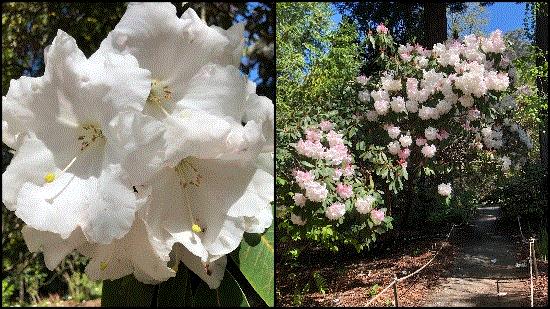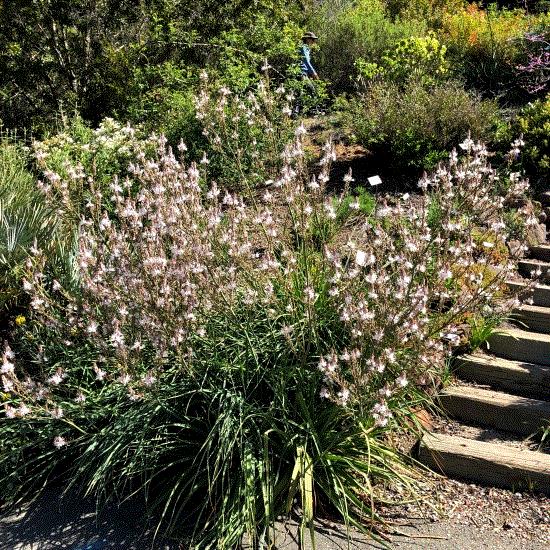Weekend Survey Time
My dear bossman Chris Beytes has an annual ritual that I wanted to shed light on—and it's a good reason to subscribe to his Acres Online Newsletter, too. Why, you ask? Because when you subscribe, you get the results of weekend surveys.

Spring weekend surveys are simple; Señor Beytes requests feedback from growers and retailers on how their last weekend went. This is an excellent indicator of the health of our industry, so I wanted to promote Chris’ efforts. Results are quite enlightening and presented by region with thoughtful prose to relay why things boomed or busted on a given weekend.
So please email Chris to tell him how this past weekend was for you. And subscribe to the Acres Online Newsletter to catch the results!
Rhododendron King George
Having grown up and attended college in rhododendron-land, I must admit it takes a lot to get me salivating over a bigleaf rhody. But then I stumbled upon Rhododendron Loderi King George at the University of California-Berkley Arboretum last week and BAM! … I found myself running down a trail. (Seriously, it was plant lust at first sight.)
I forgot about my family back in Georgia and the 21 undergraduates I was trying to keep out of jail. I just cuddled with this HUGE (15-ft. tall) beauty for a few minutes and all the world’s troubles faded away. It was, in fact, this moment I remembered that Naked Gardening Day is fast approaching.

But back to the plant ... This is an old cultivar (circa mid-late 1800s introduction of Sir Edmund Loder) that's hung around the trade. It generally reaches a mature size of 8 ft. (rounded), but in the right spot—particularly from the Central Coast of California up to Vancouver, the coastal Northeastern U.S. and northern Europe—it can become a small tree.
The most impressive facet of the plant (in my opinion) is the size of the trusses, which can reach dinner-plate size with individual flowers pushing a 4-in. diameter. It performs best in USDA Zones 6b to 7b, which is it’s only real hinderance. But if you’re in that sweet spot, it’s definitely worth finding and incorporating in a filtered sun spot with well-drained soils.

Illegal Plant Propagation on the Rise
Growers, garden centers and consumers pay a price when patented and trademarked plants are counterfeited and sold illegally. This is why a group of plant patent and trademark owners and stakeholders gathered at the Mid-Atlantic Nursery Trade Show (MANTS) on January 10, 2019 to discuss reports of unlicensed propagation of patent-protected plants in the United States.
Although illegal propagation has been a recurring issue, it appears to be on the increase in recent years. The group met to share ideas for addressing the growing problem. Attendees represented a cross-section of stakeholders: propagators and growers of trees, shrubs, perennials, fruiting plants, grasses, roses and other ornamentals. Among the businesses represented were J. Frank Schmidt & Son Co.; Bailey Nurseries; Spring Meadow Nursery; Greenleaf Nursery Company; Chicagoland Grows; Jackson Nursery; Pleasant Run Nursery, Inc.; and Star Roses and Plants.
The stakeholders who met at MANTS encourage everyone in our industry to play by the rules. The penalties are quite harsh for those who are caught on the wrong side of the law. In addition to taking initial steps to address the issue of unlicensed propagation and the unauthorized use of trademarks, the group plans to work together in educating everyone involved in the green industry, as well as the general public about the benefits and importance of plant patents and trademarks.

So Why is Illegal Plant Propagation/Sales a Problem?
Now, the majority of what's written in the previous bit is from a press release from a friend and colleague in the industry. However, I will add my 2 (editorial) cents now (as an ornamental breeder). First, illegal propagation and sales of patented/ trademarked genotypes (cultivars) hurts our industry as a whole—there's no debate about that. It comes down to the funding of innovation. In an industry (nursery and floriculture production) where innovation is key to maintaining profits for all, those who break the rules effectively stifle that innovation instead choosing personal gain over industry sustainability. It takes a special kind of selfishness to do that.
There are many examples in recent legal litigation of companies (and individuals) who pushed the limits by breaking patent and trademark rules. I’m not here to call anyone out specifically, but I will say it generally doesn't end well for the offender. It may not wind up causing a business to fail, but it certainly causes irrevocable damage to the reputation of the business or the person caught cheating. And once you get nabbed, you can be sure that you'll wind up on a few naughty lists, and as a result, will receive constant scrutiny.
That doesn’t sound like much fun …

Asphodeline taurica (King’s Spear)
I’m going to offer a prelude by saying this is a Mediterranean plant that does excellent in the western U.S., but struggles in the east unless it's grown as a container plant. It also naturally (pun intended) does quite well in southern Europe. In fact, the first place I saw it was in a small garden in Casablanca, where it was totally rocking out.
I’ve tried A. taurica, and supposedly the more hardy (in the Southern U.S.) A. lutea Italian Gold in ground at the Casa del Chappell in Georgia without much success. Nonetheless, where it does well, it's a showstopper and should be planted more frequently. It’s also a heck of a pollinator plant!

Now, the redeeming qualities of the plant (finally): It’s listed as a Zone 6- to 8-plant in many resources, but in coastal southern-central California, it does well from inland valleys to the coast. It also performs well into the Pacific Northwest if sited in a well-drained soil.
Flower spikes (of this species) produce copious white flowers that bloom over a two- to three-month period in mid-spring/early summer, attracting just about every flying insect (including moths at night). If you’re looking for another color, you can try A. lutea that has yellow flowers.
This is one of those species that as a plant breeder I've been working on for a few years to find genotypes tolerant of heavy soils, but without much luck. So if you’re successfully growing it in a clay soil, let me know!

Safari's Supplemental Labels for SLF and EAB
I pillaged this article from my good friend and colleague’s newsletter—that being Dr. J.C. Chong’s PestTalks (another one you should subscribe to). The reason I stole his prose is because it pertains to two serious pests, Emerald Ash Borer (EAB) and Spotted Lanternfly (SLF). Take it away, J.C. …

Dinotefuran is one of the most effective systemic insecticides against the spotted lanternfly (SLF), according to Penn State Extension. One of a handful of products that contains dinotefuran is Safari 20 SG. In mid-January, Nufarm America and Valent USA received a Section 2(ee) recommendation of Safari 20 SG for SLF management in 15 states. For those who aren’t familiar with the Federal Insecticide, Fungicide, Rodenticide Act, commonly known by its acronym FIFRA, Section 2(ee) recommendation specifies certain uses of an insecticide that deviate from the approved uses outlined in the insecticide label.
According to FIFRA Section 2(ee) recommendation, Safari 20 SG may be used to control SLF in Connecticut, Delaware, Kentucky, Maine, Maryland, Massachusetts, New Hampshire, New Jersey, North Carolina, Pennsylvania, Rhode Island, Tennessee, Vermont, Virginia and West Virginia. Safari 20 SG may be applied as foliar spray, drench and basal trunk spray in containerized and field-grown nurseries, outdoor landscapes, tree plantations, reforestation nurseries, forest and wooded areas. This Section 2(ee) recommendation expires on December 31, 2023. See Safari 20 SG’s Section 2(ee) recommendation for details on application.
Now, don't panic! Having a Section 2(ee) recommendation doesn't mean you have the pest in your state. This is an approval, which preempts the need to expand the label for treatment of this invasive pest when it’s found in one of the listed states. By including multiple states on the recommendation, even when SLF is yet to be detected in these states, Nufarm can quickly and legally provide the product for the management of SLF when the beast is detected. Folks in North Carolina and Vermont should try to get a good night's sleep; y’all ain’t overrun ... yet.
Folks in New York are rightfully unhappy that they aren’t included in the 2(ee) recommendation. After all, SLF has been present in New York since 2017! When it comes to pesticides, it’s never that easy in the Empire State. Pesticide regulations in New York require that a pesticide can only be used when the pest, the use site and the crop are specified on the label. In states where a pesticide can be used on a pest as long as the target use site and crops are listed on the approved label, a Section 2(ee) recommendation is sufficient as a clarification of legal use. In New York, where the pest, use site and crop have to be specified, an actual registration has to be secured from the state before a pesticide can be used.
Nufarm and Valent received a FIFRA Section 24(c) Special Local Need label for Safari 20 SG for use as a basal trunk spray against SLF on tree of heaven and the EAB on ash in New York in February. This Section 24(c) registration clears the way for landscape care professionals and grounds managers to use Safari 20 SG against SLF and the EAB in outdoor sites, ornamental landscapes and forests. See Safari 20 SG’s Section 24(c) registration in New York for details on application.

Naked Gardening Day
Hold the phones—this is really a holiday! Each year, the first Saturday in May is an international day of bliss for many … who partake in the annual tradition of lathering up in a mixture of SPF 90 and Skin-so-Soft (a known repellant of mosquitos and mayflies) to garden in the buff.
Now I'm not at all condoning the torture of your neighbors with sights that simply can’t be unseen, but it’s also a seriously ready-made marketing opportunity in our world of social media. So why not promote it! I would poll the readership as to the level of participation, but alas, this should remain PG-13 (which is also why no photos are included in this bit).
And before you participate, make sure you check those HOA regulations. It seems like they don’t take kindly to free-roaming chickens and bare bottoms!
Our Wacky Wonderful World—Notes from the Edge of Sanity
If you’re a regular reader of this newsletter, you know I'm always promoting the concept of recruiting young folks into horticulture. It’s a noble cause and worthy of praise, and that’s why I wanted to take a second to send a shout-out to all those involved with the Plant Drop (#plantdrop) events being coordinated by the Collegiate Plant Initiative.
Virginia Frazier, Dr. David Clark (University of Florida) and their band of comrades have been crossing the U.S. with one very simple, but effective, goal. Give plants away on college campuses, and as a result, spark interest in horticulture. Why? Because a majority of horticulture majors at four-year institutions don’t start as Horticulture majors. That’s right … we steal students from other departments and corrupt the best minds to enter a life of loving plants!

What does 1,000(ish) students waiting for 1,000 4-in. sedum plants look like? Well, here you go! Thanks to the Collegiate Plant Initiative for making this scene a regular occurance all over the U.S.!
Well played, ladies and gents of the Collegiate Plant Initiative! Here's a video from the University of Georgia event, where 1,000 sedums were distributed to students in just about 16 minutes. The amazing part of this is I just cruised campus for a bit after the event and spoke to those who had grabbed a plant, inviting them to a Horticulture Club meeting or to take the Intro to Horticulture course. And most had no idea horticulture was even a major, much less that we have a student organization on campus that gets together to simply get dirty and eat pizza!
Again, kudos to the Collegiate Plant Initiative for some serious horticulture PR!

Live authentic,

Matthew Chappell
Editor-at-Large
Nursery & Landscape Insider
This has been received by 30,835 of the hardest-working horticulturists in show business!
If you're interested in reaching 30,835 (and growing) clients who eagerly await every Nursery & Landscape Insider and surely read every word, contact Kim Brown ASAP and she'll hook you up. And thanks for helping us reach a community of 30,000+ fellow horticulturists! Keep spreading the word.